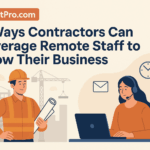Listen, if you’re running a construction company right now, you already know the deal. Finding good people is harder than pouring concrete in January. And it’s not just about bodies on the job site anymore – it’s about finding the right talent for every single role that keeps your projects moving.
Let me hit you with some reality that’ll make your hard hat spin.
The Labor Crisis Nobody’s Talking About (But Everyone’s Feeling)
The construction industry needed to fill 546,000 additional positions on top of the normal hiring pace in 2024 just to meet demand. That’s over half a million workers. And here’s the kicker – we’re not just talking about skilled trades. We’re talking about every position that makes a construction company run.
Think about it. When was the last time you tried to hire a decent estimator? Or a project coordinator who actually knows the difference between RFIs and submittals? These folks are unicorns right now, and they’re commanding unicorn prices.
The average construction company is losing 15-20% of potential revenue because they simply can’t staff up to take on more work. That’s money left on the table. Real money. Your money.
The Real Cost of Empty Desks (It’s Way More Than You Think)
Let’s break down what these shortages are actually costing you:
Direct costs you can see:
- Overtime pay through the roof (average 25-30% above normal)
- Project delays eating into your margins
- Turning down profitable jobs because you can’t staff them
- Paying premium rates for temporary workers who don’t know your systems
Hidden costs that are killing you slowly:
- Your best people burning out from overwork
- Mistakes from rushed work costing you in rework and warranties
- Damaged client relationships from missed deadlines
- Your competition stealing your exhausted employees
Add it all up? The typical mid-sized construction company is bleeding $2-3 million annually from labor shortage issues. That’s not a typo.
Here’s What Most Contractors Get Wrong About Remote Work
When I say “remote talent for construction,” I bet you’re thinking, “This guy’s lost it. You can’t pour concrete from a laptop.”
And you’re absolutely right. You can’t.
But here’s what you’re missing – only about 30% of your workforce actually needs to be on-site. The rest? They’re sitting in offices, job trailers, or driving around town for meetings that could’ve been emails.
Think about these roles:
- Estimators and cost analysts
- BIM coordinators and CAD drafters
- Project schedulers and planners
- Permit expeditors and compliance specialists
- Accounts payable/receivable staff
- Safety documentation specialists
- Marketing and business development
- IT support and data management
Every single one of these positions can be done remotely. And done better, in many cases.
The Remote Talent Goldmine (And How to Strike It)
Here’s where things get interesting. While you’re competing with every contractor in your city for the same small pool of talent, there’s an entire world of skilled professionals you’re not even considering.
The time zone advantage nobody talks about: Imagine having your estimates and shop drawings worked on while you sleep. You send requirements at 5 PM, and boom – completed work is waiting in your inbox at 7 AM. That’s not magic. That’s just smart use of global talent.
The cost equation that actually makes sense: A senior estimator in New York City costs you $95,000-$120,000 plus benefits. That same skill level from a remote professional? You’re looking at 50-70% less, without sacrificing quality. Use that savings to pay your on-site crews better. Win-win.
The expertise pool that changes everything: Need someone who specializes in healthcare facility estimates? Or someone who’s a wizard with Procore and PlanGrid? When you go remote, you’re not limited to whoever happens to live within 30 miles of your office. You get exactly the expertise you need.
Security Concerns? Let’s Address the Elephant in the Room
I know what you’re thinking. “What about my plans? My client data? My bid information?”
Fair concerns. Here’s how smart companies handle it:
For sensitive project data:
- Use secure, encrypted platforms (not email)
- Implement robust NDAs and legal protections
- Work with managed service providers who control the work environment
- Set up dedicated secure workstations that can’t download files locally
For day-to-day operations:
- Use cloud-based construction management software with built-in security
- Implement two-factor authentication on everything
- Regular security audits and access reviews
- Clear data handling protocols and training
The truth? Your data is probably safer with a properly managed remote team than it is with the guy who keeps losing his laptop at job sites.
The Skills That Transfer Perfectly to Remote Work
Let me paint you a picture of what actually works remotely:
Estimating and Preconstruction: Your estimators don’t need to smell the sawdust to calculate material quantities. With today’s digital takeoff tools, drone surveys, and 360-degree site photos, remote estimators can be more accurate than ever.
BIM and Design Coordination: This one’s a no-brainer. BIM teams are already working in digital environments. Whether they’re sitting in your office or halfway around the world, they’re looking at the same Revit model on the same screen.
Project Administration: Submittals, RFIs, change orders, daily reports – it’s all digital now anyway. A good project admin can manage this flow from anywhere with an internet connection.
Financial Management: Your bookkeepers, payroll specialists, and accounts receivable team? They’re probably already working mostly on computers. Location becomes irrelevant.
How to Actually Make This Work (Without Losing Your Mind)
Alright, so you’re interested but skeptical. Here’s your roadmap:
Start with one role: Pick your biggest pain point. Can’t find estimators? Start there. Build your remote system around one position before expanding.
Set clear expectations from day one:
- Specific working hours (even if flexible)
- Response time requirements
- Weekly check-in schedules
- Deliverable deadlines
- Communication protocols
Use the right tools (they’re not expensive):
- Project management: Monday.com, Asana, or construction-specific tools like Procore
- Communication: Slack or Microsoft Teams
- File sharing: Secure cloud storage with version control
- Time tracking: Toggl or Harvest for accountability
Build culture intentionally: Remote doesn’t mean disconnected. Regular video calls, virtual coffee breaks, and bringing remote staff to occasional company events keeps everyone aligned.
Measure what matters: Stop counting hours and start counting outcomes. Did the estimate get done accurately? Were the submittals processed on time? That’s what actually impacts your bottom line.
The Math That’ll Make You Move
Let’s run real numbers for a typical scenario:
Traditional hire for senior estimator:
- Salary: $95,000
- Benefits and taxes (30%): $28,500
- Office space and equipment: $8,000
- Total annual cost: $131,500
Now multiply that by 5-10 positions. We’re talking serious money that goes straight to your bottom line.
What’s Really at Stake Here
Look, this isn’t just about saving money or finding bodies to fill seats. This is about the future of your business.
Companies that figure out the remote talent piece are going to dominate the next decade. They’ll have lower overhead, access to better talent, and the ability to scale up or down quickly based on project needs.
Companies that don’t? They’ll keep fighting over the same shrinking pool of local talent, paying more and more for less and less, until they can’t compete anymore.
The Bottom Line
The construction labor shortage isn’t going away. If anything, it’s getting worse. But the solution isn’t to keep doing the same thing and hoping for different results.
Remote talent for non-field positions isn’t just a band-aid. It’s a competitive advantage that smart contractors are already using to eat your lunch.
The question isn’t whether you should explore remote talent for your construction business. The question is whether you’ll do it now while it’s still an advantage, or later when it’s a requirement for survival.
Every day you wait is another day of:
- Turning down profitable work
- Burning out your existing team
- Watching overhead costs climb
- Losing ground to more agile competitors
The construction industry has always been about solving problems and building something better. This is just another problem to solve. And the solution is clearer than a fresh set of plans.
Remote talent isn’t the future of construction back-office operations. It’s the present. And if you’re not taking advantage of it, you’re already behind.
Your Next Move
Stop overthinking this. Start with one position. Test the waters. See the results for yourself. Because while you’re reading this, your competition might be hiring their third remote estimator at half the cost of your last local hire.
The labor shortage is real. But the solution is sitting right in front of you. You just need to reach out and grab it.
Remember: The best time to plant a tree was 20 years ago. The second best time is now. The same goes for building your remote construction team.





